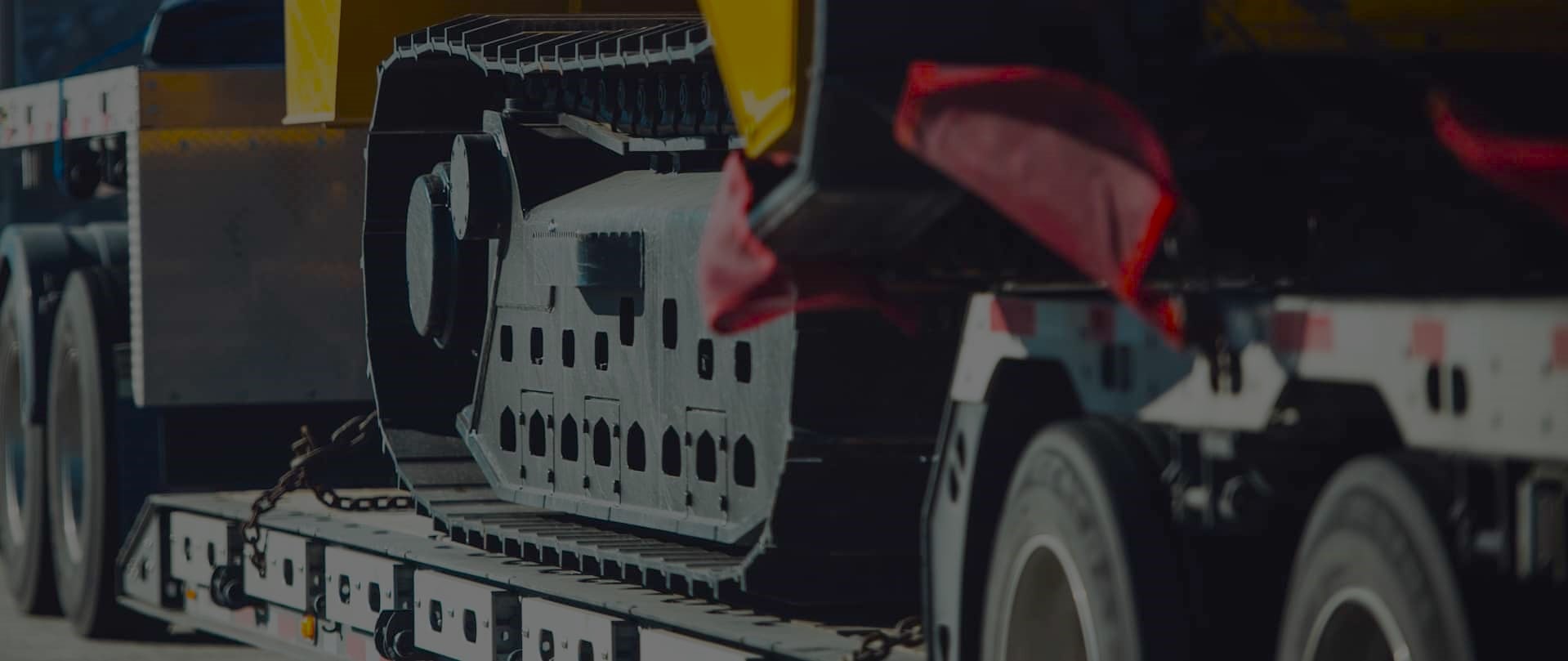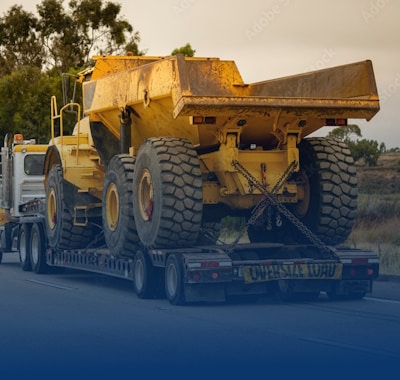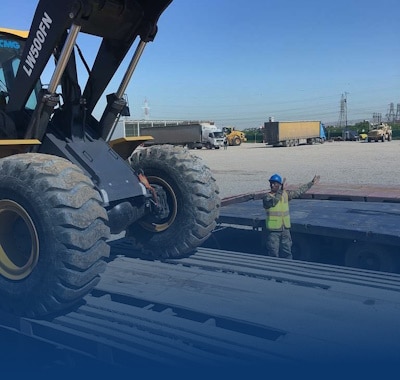Heavy Machinery Transport: Leveraging Technology for Efficiency
Freedom Heavy Haul can offer expedited Pickup and Delivery for any size shipment anywhere in the USA. Contact us today for No Hassle, No Pressure Pricing.
Moving heavy equipment has always been a complex task. Today, advanced tools are transforming the way we handle these operations. From GPS tracking to 5G connectivity, these innovations ensure smoother, safer, and more precise processes.
Safety is a top priority in this field. Modern systems provide real-time updates on equipment conditions and movements. This reduces risks and keeps operations running smoothly. Efficiency is another key benefit, as automation minimizes manual errors and speeds up tasks.
Cost reduction is also a significant advantage. By using these tools, we can optimize routes and reduce downtime. This not only saves money but also ensures timely delivery. Our team is committed to integrating these advancements to meet your business needs.
From manual methods to digital solutions, the industry has come a long way. We take pride in staying ahead of the curve, offering reliable and expert services. Let us help you navigate the challenges of heavy equipment movement with confidence.
The Evolution of Transport Technology in Heavy Machinery
The journey of moving large equipment has seen remarkable changes over the years. From basic tools to advanced systems, the industry has come a long way. Companies have embraced innovative solutions to tackle the challenges of oversized loads and complex transport needs.
From Manual Operations to Digital Integration
In the early days, transporting heavy equipment relied on manual labor and basic tools. Animal-drawn platforms were common, but they were slow and inefficient. As businesses grew, the need for better methods became clear.
Motorized vehicles marked a significant shift. These vehicles allowed for faster and more reliable transport. Today, digital integration has taken center stage. Real-time tracking systems, like GPS technology, ensure precise monitoring and safer operations.
Pioneering Milestones and Industry Shifts
The introduction of motorized vehicles was a game-changer. It allowed companies to handle larger loads with greater efficiency. Over time, the industry saw the rise of specialized vehicles designed for heavy equipment transport.
Digital solutions have further revolutionized the field. Modern systems provide real-time data, enabling businesses to make informed decisions. These advancements have enhanced operational consistency and safety.
| Era | Key Development | Impact |
|---|---|---|
| Pre-1900s | Animal-drawn platforms | Basic but limited in capacity and speed |
| Early 1900s | Motorized vehicles | Increased efficiency and load capacity |
| 2000s-Present | Digital integration and GPS tracking | Enhanced safety, precision, and real-time monitoring |
Progressive vehicles and management systems have shaped modern transport methods. Companies now rely on these solutions to meet their business needs effectively. The evolution continues, with new technologies paving the way for even greater advancements.
Transforming Operations with Real-Time Data and Telematics
Real-time data is reshaping how we manage heavy equipment operations. With telematics systems, we can monitor equipment condition and performance remotely. This ensures optimal functionality and reduces downtime.
Real-Time GPS Tracking and Data Insights
GPS tracking provides precise location data, allowing us to monitor equipment movements in real time. Advanced sensors collect valuable datum, such as fuel levels and engine health. This process ensures timely maintenance and prevents unexpected breakdowns.
We use this datum to make informed decisions. For example, if an engine shows signs of wear, we can schedule repairs before it fails. This proactive approach meets the need for reliable operations.
Enhancing Operational Efficiency Through Automation
Automation is a key advancement in heavy equipment management. Systems analyze datum to optimize routes and reduce fuel consumption. This not only saves costs but also improves productivity.
Automated alerts notify operators of potential issues. For instance, if tire pressure drops, the system sends an immediate warning. This ensures equipment remains in top condition.
| Feature | Benefit |
|---|---|
| Real-Time GPS Tracking | Precise location monitoring |
| Advanced Sensors | Detailed equipment insights |
| Automated Alerts | Proactive issue resolution |
These advancements empower us to deliver reliable and efficient services. By integrating real-time data and automation, we meet the need for precision in heavy equipment operations.
Route Planning: The Key to Successful Heavy Equipment Transport
Route planning is the backbone of efficient heavy machinery logistics. A well-crafted plan ensures safe, timely, and cost-effective transport. It involves assessing potential obstacles, securing permits, and collaborating with local authorities. We prioritize this step to minimize risks and maximize operational efficiency.
Effective Steps in Crafting a Transport Route Plan
Creating a detailed route plan requires careful consideration. Here are the key steps we follow:
- Measure Machinery Dimensions: Accurately assessing size and weight ensures compliance with road restrictions.
- Identify Permit Requirements: Securing necessary permits avoids legal issues and delays.
- Assess Infrastructure: Checking for low bridges, narrow roads, and weight limits prevents accidents.
- Use Digital Mapping Tools: Advanced tools like expert route planning for transporting heavy machinery through help select optimal routes.
Collaboration with Local Authorities and Utility Companies
Working with local authorities and utility companies is essential. They provide critical insights into road conditions and regulations. This collaboration ensures compliance and minimizes disruptions. We also coordinate with utility providers to address potential obstacles like overhead cables.
Efficient route planning is more than just logistics; it’s about safety and reliability. By integrating advanced tools and fostering partnerships, we deliver seamless heavy equipment transport solutions tailored to your needs.
Leveraging Technology for Efficient Transport of Heavy Machinery
Modern advancements are reshaping the way we handle heavy equipment logistics. By integrating advanced tools, we address the challenges of moving oversized loads with precision and safety. These innovations ensure smoother operations and reduce risks significantly.
Reducing Risks Through Automation
One of the key benefits of modern systems is the reduction of human error. Automated processes eliminate mistakes in high-risk tasks, ensuring safer transport. For example, real-time tracking systems monitor equipment conditions, preventing accidents and delays.
We’ve seen how these systems resolve critical issues efficiently. In one case, a malfunctioning engine was detected early, minimizing downtime and expediting delivery. This proactive approach ensures reliability year-round.
Comparing Past and Present Methods
Transporting heavy loads today is far safer than in earlier years. Manual methods often led to accidents and inefficiencies. Modern systems, like GPS tracking, provide real-time data, enhancing safety standards.
“The integration of advanced tools has transformed heavy equipment logistics, making it safer and more efficient than ever before.”
Benefits of Automated Tracking Systems
Automated tracking systems offer numerous advantages. They provide real-time updates on equipment location and condition. This ensures timely maintenance and prevents unexpected breakdowns.
| Feature | Benefit |
|---|---|
| Real-Time Monitoring | Prevents accidents and delays |
| Automated Alerts | Proactive issue resolution |
| GPS Tracking | Enhanced route optimization |
These systems empower us to deliver reliable and efficient services. By integrating cutting-edge solutions, we meet the challenges of heavy equipment transport with confidence.
Automation and Real-Time Decision Making in Heavy Equipment Transport
The future of heavy equipment transport is being shaped by automation and real-time decision-making. These advancements are transforming the way we handle logistics, ensuring safer and more efficient operations. By integrating advanced systems, we can address challenges like human exposure to hazardous environments and unexpected obstacles.
Advantages of Autonomous Machines and Remote Monitoring
Autonomous machines are redefining the way we approach heavy equipment transport. These systems operate continuously without fatigue, improving productivity and reducing downtime. Remote monitoring allows us to oversee operations from a safe distance, minimizing risks in hazardous environments.
For example, real-time data from sensors provides insights into equipment conditions. This ensures timely maintenance and prevents potential failures. By leveraging automation in heavy haul logistics, we can make informed decisions that enhance operational efficiency.
Implementing Fail-Safe and Predictive Maintenance Systems
Fail-safe mechanisms are essential for preventing accidents. These systems automatically halt operations when an obstacle or hazard is detected. This ensures a safer working environment for both equipment and personnel.
Predictive maintenance systems further enhance safety by identifying potential issues before they escalate. For instance, if a component shows signs of wear, the system alerts us to schedule repairs. This proactive approach minimizes downtime and ensures continuous operations.
| Feature | Benefit |
|---|---|
| Autonomous Machines | Continuous operation without fatigue |
| Remote Monitoring | Reduced human exposure to hazards |
| Fail-Safe Mechanisms | Automatic halt during obstacles |
| Predictive Maintenance | Prevents unexpected breakdowns |
“Automation and real-time decision-making are paving the way for a safer and more efficient future in heavy equipment transport.”
We are committed to integrating these technological solutions to meet the challenges of heavy equipment logistics. By focusing on safety, efficiency, and reliability, we ensure a secure environment for all operations. The future of transport is here, and we are ready to lead the way.
Integrating Emerging Trends: AI, IoT, and Predictive Analytics
The integration of AI and IoT is revolutionizing heavy equipment logistics. These advanced tools provide real-time monitoring and actionable insights, ensuring smoother operations. By leveraging predictive analytics, we make data-driven decisions that enhance productivity and reduce downtime.
Opportunities for Enhanced Productivity
AI and IoT are transforming how we manage oversized loads. These tools offer real-time data on equipment conditions, enabling proactive maintenance. For example, sensors detect potential issues before they escalate, ensuring timely repairs and minimizing disruptions.
Predictive analytics further boosts efficiency by optimizing routes and schedules. This not only saves time but also reduces fuel consumption and operational costs. By integrating these systems, we ensure reliable and on-time transport for our clients.
Challenges and Cybersecurity Considerations
While these technologies offer significant benefits, they also present challenges. Cybersecurity risks are a major concern, as sensitive data can be vulnerable to breaches. We address this by implementing robust security measures, including encrypted communication and regular system audits.
Another challenge is the cost of implementation. Advanced systems require significant investment in infrastructure and training. However, the long-term benefits, such as increased productivity and reduced downtime, outweigh the initial expenses.
| Feature | Benefit |
|---|---|
| AI and IoT Integration | Real-time monitoring and proactive maintenance |
| Predictive Analytics | Optimized routes and reduced downtime |
| Cybersecurity Measures | Protection of sensitive data |
“The integration of AI and IoT is not just a trend; it’s a necessity for modern heavy equipment logistics.”
We are committed to staying ahead of the curve by adopting these advanced tools. By focusing on safety, efficiency, and reliability, we ensure seamless operations for our clients. The future of transport is here, and we are ready to lead the way.
Looking Ahead: A Future Driven by Technological Advancements
The future of heavy equipment logistics is being shaped by cutting-edge innovations. We project ongoing advancements will transform planning, fuel efficiency, and customer satisfaction. These changes will set new operational standards across the industry.
Improved planning software will ensure timely deliveries, even in the face of potential delays. Enhanced route optimization tools will minimize disruptions and keep operations on track. This proactive approach ensures reliability and efficiency.
Fuel efficiency and reduced accidents through advanced automation will redefine cost management. By integrating these systems, we aim to lower operational expenses while maintaining safety. This benefits both our clients and the environment.
We are committed to investing in emerging technologies that enhance service across varied locations. Our focus on innovation ensures we remain at the forefront of the industry. This dedication guarantees top-tier solutions for our customers.
As we look ahead, our proactive planning and continual adoption of new tools will drive success. The future is bright, and we are ready to lead the way in heavy equipment logistics.







